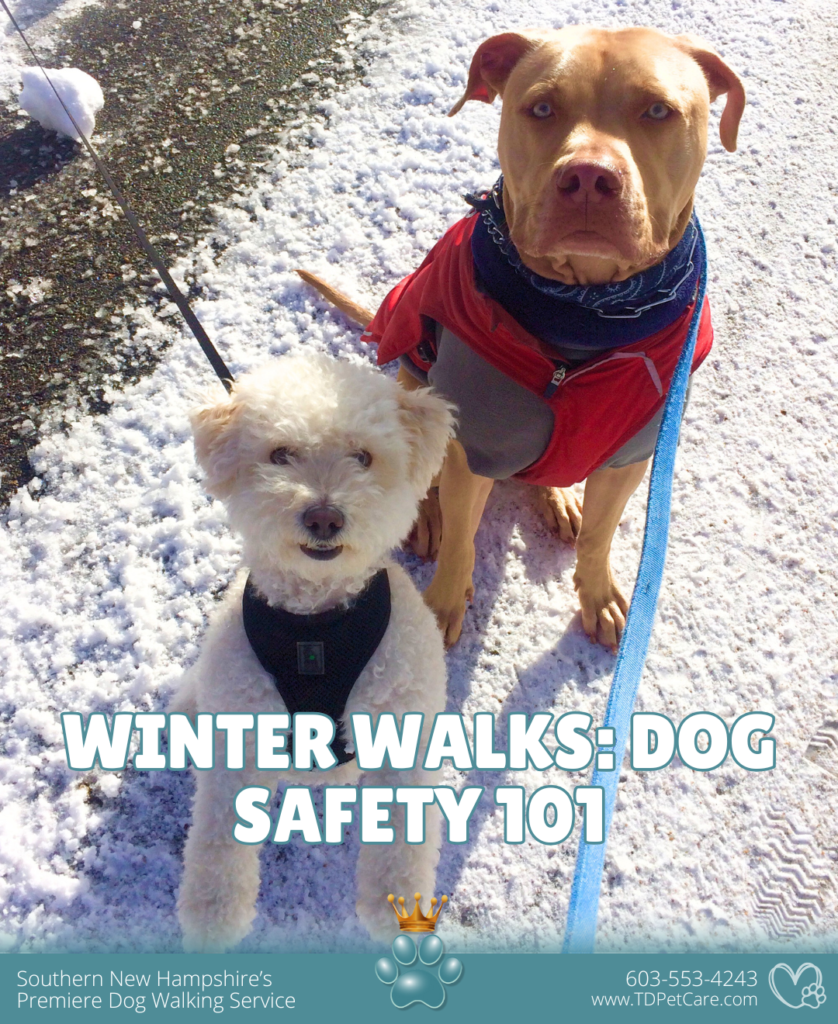How to Keep Your Dog Safe, Warm, and Happy When the Temperature Drops
New Hampshire winters don’t play around — and neither do we. Snow, ice, wind, freezing rain… your dog still needs exercise, but winter walking comes with real risks. Here’s a no-nonsense guide to keeping your dog safe and comfortable when the cold hits.

1. Know Your Dog’s Limits
Not every dog handles winter the same way.
- Short-haired breeds (boxers, pit bulls, greyhounds) get cold fast.
- Small dogs lose heat quicker.
- Seniors and puppies have a tougher time regulating temperature.
- Arctic breeds (huskies, malamutes) can handle more but still have limits.
Rule of thumb: if you’re cold, they’re cold — and it’s time to head in.
2. Protect Their Paws From Ice, Salt, and Chemicals
Sidewalk salt and ice melt can burn paws, cause cracks, or lead to stomach issues if licked off later. Keep paws safe with:
- Dog booties (best protection)
- Paw balm before and after walks
- Wiping paws as soon as you get back inside
Bonus: this also keeps your floors clean.
3. Dress for the Weather — Yes, Your Dog Too
A winter coat isn’t “extra.” In freezing temps, it’s basic protection.
Choose a coat that covers:
- Chest
- Stomach
- Back
Avoid anything bulky that restricts movement. A good coat + short winter walks go a long way for comfort and safety.
4. Avoid Hidden Dangers Under Snow
A fresh layer of snow hides a lot:
- Frozen puddles
- Sharp ice
- Uneven ground
- Road salt piles
- Holes or gaps in sidewalks
A simple misstep can lead to cuts, sprains, or slips. Walk slowly, especially with excitable pups.
5. Watch for Frostbite & Hypothermia
These creep up fast. Know the warning signs.
Frostbite signs:
- Pale skin on ears, paws, or tail
- Cold, hard patches
- Pain when touched
Hypothermia signs:
- Shivering
- Sluggishness
- Weakness
- Whining or anxiety
If you notice any of these, get inside immediately and warm your dog gradually (no direct heat).
6. Stick to Safe Walking Routes
Winter can turn normal paths into hazards.
Choose routes that are:
- Well-lit
- Frequently plowed
- Low-traffic
- Free of deep snowbanks
- Less icy (avoid hills)
If sidewalks are too slick, walk on fresh snow along the edge for better traction.
7. Keep Night Walks Short and Visible
Winter means early sunsets. Make visibility a priority.
Use:
- Reflective leashes
- Reflective coats
- LED collar lights
- A headlamp for you
Drivers can’t avoid what they can’t see.
8. Don’t Forget Hydration
Dogs can dehydrate even when it’s cold. Snow doesn’t count as a water source.
Make sure they drink before and after the walk — especially active or high-energy breeds.
9. Know When to Skip the Walk
Harsh wind chill, freezing rain, or sub-zero temps? Skip the long walk and go for a quick bathroom break instead.
On extreme weather days, indoor enrichment keeps dogs mentally stimulated:
- Puzzle feeders
- Hide-and-seek
- Snuffle mats
- Short training sessions
A tired brain is just as important as a tired body.
10. When in Doubt, Call in a Pro
Top Dog Pet Sitting & Dog Walking knows New Hampshire winters — and how to keep pets safe in them. Our team handles everything from short relief breaks to full walks, even on the coldest days.
If you’re busy, traveling, or don’t want to brave the ice, we’ve got your back (and your dog’s paws).
Final Thoughts
Winter doesn’t stop a dog’s need for exercise, but it does require extra care. With the right gear, awareness, and routine, you can keep your dog healthy, safe, and happy all season long — no matter what New Hampshire weather throws your way.

Recent Comments